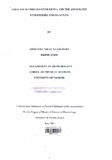| dc.description.abstract | The occurrences of cold air outbreaks have been associated with losses of human life, animal
and crops, usage of energy and many other socio-economic miseries. In this study the
objective was to investigate the cold air outbreaks over Kenya and associated circulation
patterns. The understanding of the circulations associated with cold air outbreaks is an
important step toward the development of the medium and longer range temperature
forecasting in the region. The study was concentrated within the months of June to August,
which constitute the major cold season over the region. The data sets used included daily and
monthly station maximum temperatures, and National Centre for Environmental Prediction-
National Centre for Atmospheric Research (NCEP-NCAR) global re-analyses data sets for
wind at various levels. The data that were used extended within the period 1960-2005.
Statistical and graphical methods were used to examine the evolutions of the cold air
outbreaks including determination of the anomalous cold and warm years, onset, withdrawal,
duration and other evolutions of the various anomaly spells. The statistical methods used
included Principal Component Analysis (PCA), spectral analysis and the time-crosssectional
analyses. The circulation patterns and trajectories associated with cold air outbreaks
were investigated. The trajectories based on the Hybrid Single-Particle Lagrangian Integrated
Trajectory (HYSPLIT) model and vector wind analyses were used to establish the source of
cold air.
The study confirmed that June to August is the coldest season in Kenya and that July is the
coldest month at most stations. The 1960's had a high frequency of the cold air outbreak days
showing that 1960's was the coldest decade while 1980s the warmest decade. It was
further noted that 1968 / 1983 were the coldest/warmest years respectively. Also, the study
delineated the country into ten homogenous maximum temperature zones.
Results from spectral analysis showed peaks centered around 2.0-2.9 years, 3-4 years, 4.5-6.5
years, and 10-12.5 years. Some of these peaks were associated with global quasi-periodic
oscillations such as EL-Nino/Southern oscillation (ENSO) and the Quasi-Biennial Oscillation
(QBO). Intra-seasonal spectral peaks were also.evident from the study which included Quasi-
Biweekly (QBW) Oscillations. The study also showed decreasing/ increasing trend of
maximum temperature at some locations.
From the vector wind and trajectory analyses, it was noted that cold air incursions originated
from near the point 25QS and 35QE over eastern South Africa and takes 3-4 days to reach
Kenya. These findings can be incorporated in to an early warning system which can be used
to mitigate the adverse effects of the extreme cold temperatures on agriculture, energy,
tourism and any other sector. dependent on temperature. | en |

